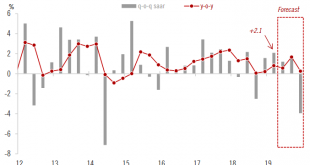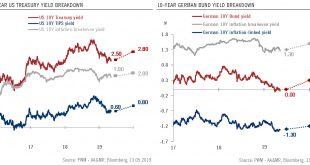Japan’s latest GDP report reveals some notable weakness in the economy despite the strong headline figures. The preliminary reading of Japanese GDP for Q1 shows that the economy grew by 2.1% q-o-q annualised, beating the consensus forecast of -0.2%. However, behind the strong headline figures, details of the GDP report reveal some broad-based weakening in momentum. Declining corporate capex and sluggish household...
Read More »Rising downside risks to euro area growth
While our forecasts remain unchanged for now, external drags on growth prospects for the euro area look set to persist for longer than we had previously expected.A potential improvement in euro area growth in H2 2019 on the back of a revival in the global economy is in jeopardy due to the intensifying trade dispute between the US and China. The euro area is not directly affected, but its indirect exposure to this dispute is not insignificant. Potentially weaker domestic demand in the US,...
Read More »Weakening Japanese momentum behind strong GDP figures
Japan’s latest GDP report reveals some notable weakness in the economy despite the strong headline figures.The preliminary reading of Japanese GDP for Q1 shows that the economy grew by 2.1% q-o-q annualised, beating the consensus forecast of -0.2%.However, behind the strong headline figures, details of the GDP report reveal some broad-based weakening in momentum.Declining corporate capex and sluggish household consumption both drag on domestic demand.The seemingly strong net exports in Q1...
Read More »Weekly View – Modi makes it
The CIO office’s view of the week ahead.We are in the midst of a decisive elections season, from the surprise, poll-defying victory of the conservative coalition in Australia and Indian general elections last weekend to the European parliament elections in the week ahead. Exit polls suggest Indian prime minister Narendra Modi and his Bharatiya Janata party are likely to return to power with a parliamentary majority. This was positive for Indian equities, which we retain an overweight...
Read More »US-China trade update
Reasoning suggests China will not use US treasuries or the RMB as trade weapons.Trade tensions between the US and China have risen sharply but we believe the situation would need to escalate much further before China resorts to the extreme weapons of currency devaluation and/or selling down its US Treasuries.The fundamental reason for this argument is that such strategies do not serve China’s own interests. On the contrary, they could cause severe damage to the Chinese economy.Should markets...
Read More »China growth moderates in April
After a strong first quarter for Chinese growth, signs point to a weaker Q2.Latest hard data indicate that China’s growth momentum moderated in April, after a strong Q1. Industrial activity, fixed investment and consumption all weakened in April.In the context of escalating trade tensions with the US, we expect the Chinese government to step up stimulus measures to support growth in the coming months, especially in the area of infrastructure investment and household consumption.Given the...
Read More »Core sovereign bond yields – update
We are adjusting downward our year-end targets for the 10-year US Treasury and Bund yields. Taking hold of two important changes to our central macroeconomic scenarios, we are adjusting downward our year-end target for the 10-year US Treasury yield from 3.0% to 2.8% and the Bund yield from 0.5% to 0.3%. The drivers behind this include lower inflation expectations, rising US-China trade tensions against a constant...
Read More »No doubt remaining: German domestic demand is resilient
German activity has accelerated in the first quarter of the year on the back of a strong domestic economy.German GDP rose by 0.4% quarter-on-quarter in Q1, accelerating from a flat figure in Q4.The strong Q1 GDP growth is good news and confirms our long-held view that domestic demand remains resilient despite many external headwinds.The signal given by other data (factory orders, surveys) suggests that some negative payback is likely in Q2.The prospect of higher German growth (on average) in...
Read More »Core sovereign bond yields – update
We are adjusting downward our year-end targets for the 10-year US Treasury and Bund yields.Taking hold of two important changes to our central macroeconomic scenarios, we are adjusting downward our year-end target for the 10-year US Treasury yield from 3.0% to 2.8% and the Bund yield from 0.5% to 0.3%. The drivers behind this include lower inflation expectations, rising US-China trade tensions against a constant monetary policy backdrop.Four consecutive disappointing US inflation prints have...
Read More »US-China trade: New tariffs – watch the second derivative
Our view about US-China trade tensions remains largely unchanged. We expect limited direct impact on the US economy, but the indirect costs could be more significant.The direct macro cost on the US economy of the raised tariffs to 25% from 10%, and the fresh counter-tariffs from China, should be limited in our view, at around 0.1% of US GDP.The US economy tends to be much more sensitive to financial conditions than to the narrow question of the tariffs’ impact on end-purchasers in the US....
Read More » Swiss Economicblogs.org
Swiss Economicblogs.org


